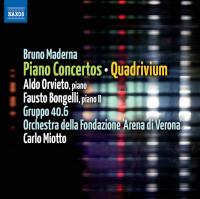Bruno Maderna
Presentato il 22 giugno 1942 nel contesto del “Corso Internazionale di perfezionamento per compositori” tenuto da Gian Francesco Malipiero a Venezia (tra gli allievi del corso erano Bruno Maderna e il pianista Gino Gorini) il Primo Concerto per pianoforte e orchestra rappresenta un momento di autentica immediatezza di scrittura, testimonianza di equilibrio tra sviluppo tecnico e solidità strutturale. In comune con le altre opere pianistiche del periodo, il lavoro (recentemente ritrovato a Verona tra le carte della pianista Bianca Coen) sfoggia una parte solistica brillante e a tratti virtuosistica integrata in un raffinato contesto timbrico orchestrale, con ricercatezze audaci che fanno presagire il Maderna geniale orchestratore della maturità.
Bruno Maderna teneva molto al Concerto, ne è la prova che, nella primavera del 1946, grazie all’amicizia con Bianca Coen il cui fratello Buby risiedeva a Londra, aveva tentato di proporne un’esecuzione forse ad opera di Arturo Benedetti Michelangeli il quale in quegli anni si preparava al suo debutto londinese. Per sostenere l’esecuzione del Concerto presso gli organizzatori delle stagioni concertistiche londinesi, Maderna preparò una trascrizione per due pianoforti che si proponeva di incidere lui stesso insieme a Gino Gorini: “Mi sono interessato e ho trovato da inciderlo in quei dischi di metallo che fanno oggi alla radio”, scriverà in una lettera alla madre adottiva, Irma Manfredi il 4 aprile 1946. Non sappiamo se l’incisione mai avvenne, ma la trascrizione pianistica è miracolosamente sopravissuta: una copia eliografica del manoscritto è stata ritrovata da Giovanni Morelli nel 2007 nel corpus del Fondo Gorini presso la Fondazione Giorgio Cini di Venezia. Tale versione, pianistica, di estremo interesse, non rivela sostanziali differenze rispetto alla partitura del Concerto del 1941, ma risulta un testimone prezioso per valutare i grandi progressi musicali di Maderna nel periodo 1941/46: Maderna infatti – trascrivendo per due pianoforti – via via corregge e aggiorna dinamiche e agogiche della partitura alla luce della sua più recente tecnica e sensibilità musicale.
